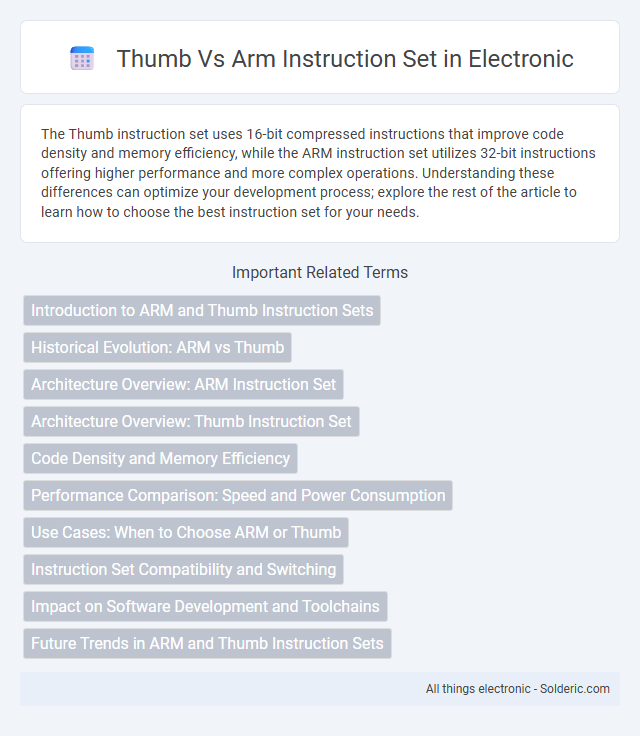The Thumb instruction set uses 16-bit compressed instructions that improve code density and memory efficiency, while the ARM instruction set utilizes 32-bit instructions offering higher performance and more complex operations. Understanding these differences can optimize your development process; explore the rest of the article to learn how to choose the best instruction set for your needs.
Comparison Table
| Feature | Thumb Instruction Set | ARM Instruction Set |
|---|---|---|
| Instruction Width | 16-bit | 32-bit |
| Code Density | High (compact code) | Lower (larger code size) |
| Performance | Moderate (faster code fetch) | Higher (more complex instructions) |
| Register Usage | Limited registers (subset of ARM registers) | Full 16-register set |
| Instruction Complexity | Simplified | Comprehensive |
| Use Case | Embedded systems, low memory footprint | Performance-critical applications |
| Compatibility | Interworks with ARM instructions via mode switching | Base instruction set for ARM CPUs |
Introduction to ARM and Thumb Instruction Sets
ARM instruction set uses 32-bit fixed-length instructions designed for high performance and extensive computational tasks, while Thumb instruction set employs 16-bit compressed instructions optimized for reduced code size and improved memory efficiency. The Thumb set enhances code density, enabling Your applications to use less memory and potentially lower power consumption without significantly sacrificing performance. Selecting between ARM and Thumb depends on balancing execution speed and code size, with ARM suited for computation-heavy tasks and Thumb for memory-constrained environments.
Historical Evolution: ARM vs Thumb
The ARM instruction set was introduced in the early 1980s with a focus on high-performance 32-bit operations, while the Thumb instruction set emerged in the mid-1990s as a compact 16-bit subset designed to improve code density and reduce memory footprint. Thumb instructions enable better efficiency in embedded systems by offering a trade-off between execution speed and binary size, facilitating more efficient use of limited memory resources. The evolution of ARM processors includes the integration of both ARM and Thumb modes, with later architectures supporting Thumb-2 technology that combines the benefits of both instruction sets for enhanced performance and code density.
Architecture Overview: ARM Instruction Set
The ARM instruction set architecture (ISA) is designed for high performance and energy efficiency, featuring a 32-bit fixed-length encoding for most instructions. Thumb is a compressed 16-bit subset of the ARM ISA aimed at reducing code size and improving memory efficiency, making it ideal for embedded systems with limited resources. ARM supports both ARM and Thumb modes, enabling seamless switching to optimize between computational power and code density.
Architecture Overview: Thumb Instruction Set
The Thumb instruction set is a compact, 16-bit encoding of the ARM architecture designed to improve code density and reduce memory usage without significantly compromising performance. It simplifies the instruction format, enabling faster instruction fetch and lower power consumption, which is ideal for embedded systems and applications with constrained resources. By using Thumb, your applications can benefit from enhanced efficiency while maintaining compatibility with the broader ARM ecosystem.
Code Density and Memory Efficiency
Thumb instruction set improves code density by utilizing 16-bit compressed instructions compared to the 32-bit ARM instruction set, effectively reducing memory usage. This compact encoding allows for more efficient use of cache and memory bandwidth, leading to enhanced memory efficiency in embedded and resource-constrained environments. Reduced instruction size in Thumb minimizes the memory footprint without significantly compromising performance, making it ideal for applications requiring lower code size.
Performance Comparison: Speed and Power Consumption
Thumb instruction set improves code density by using 16-bit instructions, resulting in faster memory access and lower power consumption compared to the 32-bit ARM instruction set. ARM instructions typically execute more complex operations per cycle, offering higher raw performance but at the cost of increased power usage and larger code size. Choosing between Thumb and ARM affects your device's balance of speed efficiency and energy consumption, critical for optimizing embedded and mobile applications.
Use Cases: When to Choose ARM or Thumb
ARM instruction set suits applications requiring high performance and complex processing tasks, such as operating systems, multimedia, and advanced computing. Thumb instruction set is ideal for embedded systems and battery-powered devices where code size and power efficiency are critical. You should choose Thumb for memory-constrained environments and ARM for scenarios demanding maximum processing speed and computing power.
Instruction Set Compatibility and Switching
The Thumb instruction set offers a compact 16-bit encoding compatible with the standard 32-bit ARM instruction set, enabling efficient memory usage and faster code execution on resource-constrained devices. Switching between ARM and Thumb modes is seamless through specific branch instructions, allowing You to optimize performance and code size dynamically in embedded systems. This compatibility ensures that code compiled in one mode can interoperate with routines written in the other, maintaining system stability and flexibility.
Impact on Software Development and Toolchains
The Thumb instruction set, characterized by 16-bit compressed instructions, enhances software development efficiency by reducing code size and improving memory utilization, which is essential for resource-constrained embedded systems. Toolchains optimized for Thumb provide streamlined debugging and compilation processes, enabling faster build times and easier integration with performance analysis tools. In contrast, the ARM instruction set, with its 32-bit instructions, offers more powerful computational capabilities but demands larger code storage, influencing developers to balance performance needs against memory limitations when choosing between the two.
Future Trends in ARM and Thumb Instruction Sets
Future trends in ARM and Thumb instruction sets emphasize increased efficiency and performance for embedded and mobile devices. ARM architecture continues to evolve with enhanced 64-bit support and improved SIMD capabilities, while Thumb instruction sets focus on higher code density and reduced power consumption. Understanding these advancements helps you optimize your software for upcoming ARM platforms.
thumb vs arm instruction set Infographic

 solderic.com
solderic.com